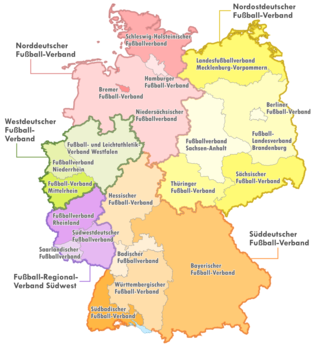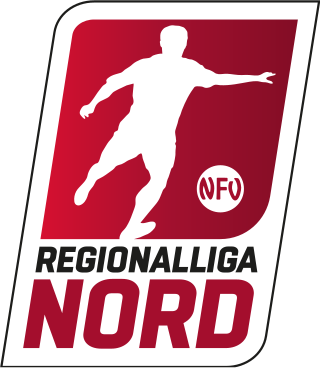
The Oberliga is the fifth tier of the German football league system. Before the introduction of the 3. Liga in 2008, it was the fourth tier. At the end of the 2011–12 season the number of Oberligas was increased from eleven to fourteen.
The German football league system, or league pyramid, refers to the hierarchically interconnected league system for association football in Germany that in the 2016–17 season consisted of 2,235 leagues in up to 13 levels having 31,645 teams, in which all divisions are bound together by the principle of promotion and relegation.

The Regionalliga Nord is the fourth tier of the German football league system in the states of Lower Saxony, Schleswig-Holstein, Bremen and Hamburg. It is one of five leagues at this level, together with the Regionalliga Bayern, Regionalliga Nordost, Regionalliga Südwest and the Regionalliga West. Until the introduction of the 3. Liga in 2008 it was the third tier.
The Oberliga Süd was the southernmost of the five Oberligen, the regional leagues forming the top level of association football in West Germany from 1945 until the formation of the Bundesliga in 1963. Oberliga Süd covered the southern three German states of Bavaria, Baden-Württemberg and Hesse.

The 2. Bundesliga Nord was the second-highest level of the West German football league system in the north of West Germany from its introduction in 1974 until the formation of the single-division 2. Bundesliga in 1981. It covered the northern states of North Rhine-Westphalia, Lower Saxony, Bremen, Hamburg, Schleswig-Holstein and the city of West Berlin.

The Regionalliga Nord was the second-highest level of the German football league system in the north of Germany from 1963 until the formation of the 2. Bundesliga in 1974. It covered the states of Niedersachsen, Bremen, Hamburg and Schleswig-Holstein.

The Oberliga West was the highest level of the German football league system in the west of Germany from 1947 until the formation of the Bundesliga in 1963. It covered the state of North Rhine-Westphalia, the most populous state of Germany.

The Oberliga Nord was the fourth tier of the German football league system in the north of Germany. It covered the states of Lower Saxony, Bremen, Hamburg and Schleswig-Holstein. With the introduction of the 3. Liga, the league ceased to exist from 2008.

The Oberliga Hamburg/Schleswig-Holstein was the fourth tier of the German football league system in the north of Germany, existing from 1994 to 2004. It covered the states of Hamburg and Schleswig-Holstein. With the re-formation of the Oberliga Nord in 2004, the league was disbanded.

The Oberliga Hamburg, sometimes referred to as Hamburg-Liga, is the highest league in the German state of Hamburg, incorporating some of its surrounding districts. It is one of fourteen Oberligen in German football, the fifth tier of the German football league system.

The Oberliga Schleswig-Holstein, formerly referred to as Schleswig-Holstein-Liga, is the fifth tier of the German football league system and the highest league in the German state of Schleswig-Holstein. It is one of fourteen Oberligas in German football.

The Oberliga Niedersachsen, sometimes referred to as Niedersachsenliga, is the fifth tier of the German football league system and the highest league in the German state of Lower Saxony. Since 1994, the league was split into a western and an eastern group. In 2010, it returned to a single-division format. The Oberliga moved to a north-south split for one season in 2020. It is one of fourteen Oberligen in German football, the fifth tier of the German football league system.

The Gauliga Niedersachsen was the highest football league in the Prussian Province of Hanover and the German states of Bremen, Brunswick, Schaumburg-Lippe and Oldenburg from 1933 to 1945. Shortly after the formation of the league, the Nazis reorganised the administrative regions in Germany, and the GaueSüdhannover-Braunschweig, Ost-Hannover and Weser-Ems de facto replaced the Prussian province and the German states in the region of Lower Saxony (German:Niedersachsen), although de jure the old states continued to exist.

The Goslarer SC 08 is a German association football club from the city of Goslar, Lower Saxony.
The Introduction of the Bundesliga was the long-debated step of establishing a top-level association football league in Germany in 1963. The new league, the Bundesliga, played its first season in 1963–64 and continues to be the highest league in the country. Its introduction reduced the number of first division teams in Germany from 74 to 16 and finally eliminated the problem of the top-teams having to play uncompetitive teams in regional leagues.
The Introduction of the 2. Bundesliga was the step of establishing a professional second tier association football league in Germany in 1974. The new league, the 2. Bundesliga, played its first season in 1974–75 and continues to be the second-highest league in the country. Its introduction reduced the number of second divisions in Germany from five to two and the number of teams at this level from 83 to 40. It eliminated the necessity of having a promotion round at the end of the season to determine the two teams promoted to the Bundesliga.
The Verbandsliga Norddeutschland was one of several association football first tier leagues in the German Empire. The league only existed for one season and covered the area administered by the Northern German Football Association.
The 1974–75 season of the Oberliga was the inaugural season of the Oberliga as a tier-three league. The Oberligas, then as tier-one leagues, had been disestablished after the 1962–63 season, when the Bundesliga was introduced.
The 2017–18 Hamburger SV season was the 99th season in the football club's history and 55th consecutive and overall season in the top flight of German football, the Bundesliga, having been promoted from the Oberliga Nord in 1963. Finishing 17th, Hamburg was relegated for the first time in the Bundesliga's 55-year history. In addition to the domestic league, Hamburger SV also participated in this season's edition of the domestic cup, the DFB-Pokal. This was the 65th season for Hamburg in the Volksparkstadion, located in Hamburg, Germany. The season covers a period from 1 July 2017 to 30 June 2018.
The 1953–54 Hannover 96 season is the 58th season in the football club's history and sixth overall season in the top flight of German football, the Oberliga Nord, and their fifth consecutive season having been reinstated in 1949 after appealing against their relegation to the Landesliga Niedersachsen in 1948. Hannover 96 won the Oberliga Nord and advanced to the championship finals for the fifth overall time, where they won their second German championship after 1938. The season covers a period from 1 July 1953 to 30 June 1954.












